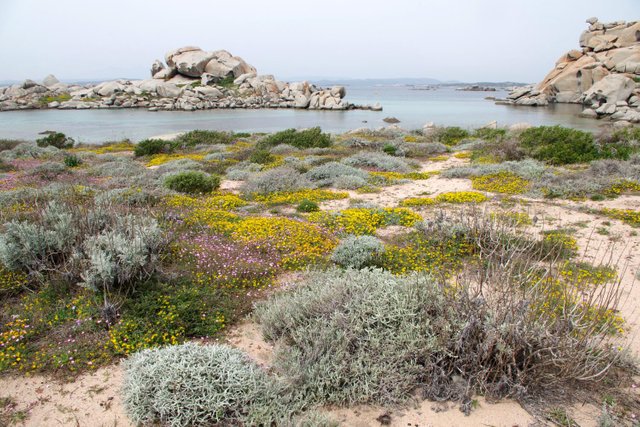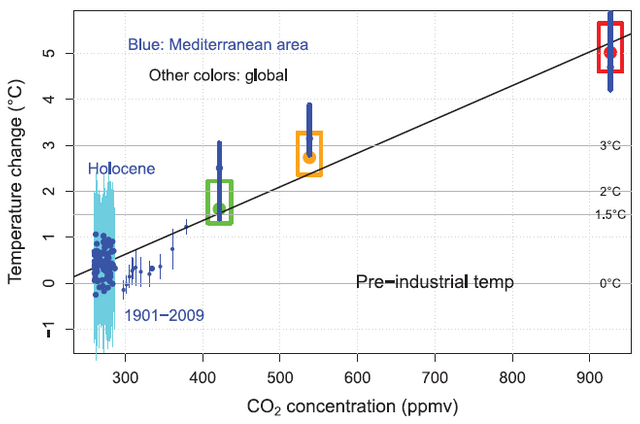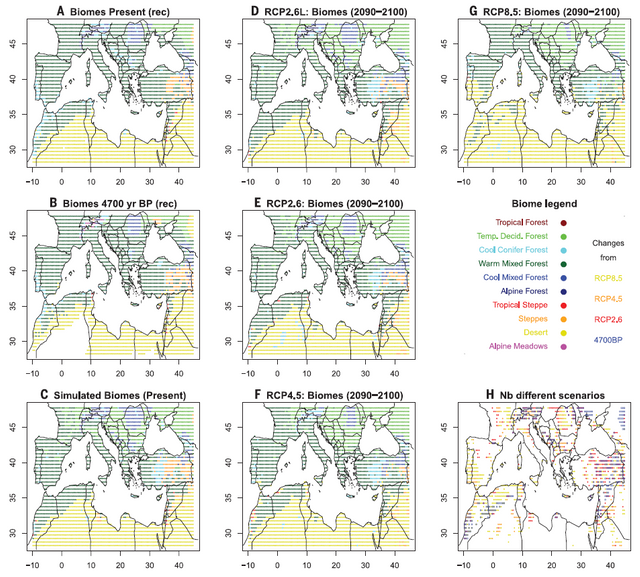Rising temperatures will turn Spain into the desert.

Lavezzi Island (Corsica region, France). Photo: Daniel Pavon, IMB, Aix Marseille University
The bad news for investors, who gathered on the cheap to buy a house or an apartment in the resort town of Greece or Spain. Climatologists warn that even while limiting the global average warming we are waiting for significant climate change in specific regions. If the increase will go according to the pessimistic scenario, the consequences will be very unpleasant. For example, Southern Spain will become a desert.
According to the Paris agreement of 2015, under the UN Framework Convention on Climate Change, the country agreed to reduce CO2 emissions in order to keep warming within 2 ° C above pre-industrial levels, as well as "efforts to limit temperature rise to within 1.5 ° C above pre-industrial levels.
It would seem - perfectly. The countries finally agreed. Temperature will rise by only a few degrees, and more will not grow. All is well.
But climatologists add a bit of pessimism in this idyllic picture. They note that the global average temperature increase of 2 ° C is significantly greater increase in mean temperatures in some regions. At the same time daily highs reach extreme values. That is, on some days the temperature outside is just killer. The result of modeling this situation was published in January 2016 in the journal Nature by specialists of the Institute of Atmospheric and Climate Sciences, ETH Zurich (Switzerland), the Research Centre of the University Climate Change South Wales (Australia) and Loughborough University (UK), doi: 10.1038 / nature16542.
The recent rise in global average temperature less than 1 ° C, has already led to a significant destabilization and disruption of many existing ecosystems, which are detailed in the Fifth Assessment Report (AR5) of the Intergovernmental Panel on Climate Change (IPCC), particularly with regard to A.
Some regions of the world are located in the zone of special risk. Climate scientists can not say with certainty, in which specific regions of the world will grow particularly strongly with an increase in temperature of average level of 2 ° C above pre-industrial levels. But if we extrapolate the current situation, the inhabitants of some countries will have hard times.
At the moment, the global average temperature rose by just 0.85 ° C relative to pre-industrial levels, but particularly in the Mediterranean, an increase of about 1.35 ° C. Even the optimistic scenario of the UN Framework Convention on Climate Change (green rectangle on the chart) looks threatening for the region.

Colored rectangles on the chart correspond to the framework laid down in the various scenarios of the UN Framework Convention on Climate Change in the 2010-2100 biennium. Blue circles and blue vertical stripes denote the same framework for the Mediterranean region.
According to the forecast, the growth of the global average temperature by 1.5 ° C or> 2 ° C - these are two completely different scenarios for the Mediterranean. Researchers from the European Centre for Research and Teaching of Ecology and Earth Sciences prepared the results of climate simulations under various scenarios of global warming. The scientific work is published October 28, 2016 (doi: 10.1126 / science.aah5015).
Very few simulations of climate until the end of the 21st century allow improving the climate in less than 2 ° C. The problem is that the Mediterranean is very sensitive not only to the increase in temperature, but also to the lack of fresh water. This means that a further increase in temperature and drought threaten significant change in plant diversity in the local ecosystem. As the historical reconstruction, for the upcoming Mediterranean drought exceeds all the historical periods of drought Holocene epoch, even taking into account the measurement error (blue vertical border on the top left of the diagram below). As we know from past research work, the drought in the region contributed to the decline of civilizations in the Mediterranean. And it was the drought on a smaller scale than the one that waits for the Mediterranean in the near future. Now history repeats itself like. For the period 1998-2012 years in Syria and other countries of the western Mediterranean was the driest in 500 years. Coincidentally, during this period is tense social situation.
The researchers stress that the Mediterranean - an important region of the world in terms of biodiversity. It is home to diverse flora and fauna, there are sources of fresh water. Although this is a relatively small patch of the planet, but still do not want to lose it.
The simulation shows a map of the Mediterranean biome biome historical reconstruction, the current situation and outlook, how to change the natural ecosystems of the climatic zone under different scenarios of global warming.

Simulations for ambitious scenarios RCP2.6L RCP2.6 and do not show significant changes in biome to the end of the 21st century, but here's a more extreme scenario RCP4.5 shows the expansion of the desert in North Africa, the degradation of alpine forests and expansion of sclerophyllous vegetation zones in the Mediterranean. Probably, this scenario can be considered as the most realistic.
According to the scenario RCP8.5 southern areas of Spain are turning into deserts, deciduous forests capture most of the mountains and the Mediterranean vegetation comes to the place of hardwood forests in most parts of the Mediterranean. As seen in the diagram 3H, climate change will affect the territory of Ukraine and Russia.
According to scientists, the only acceptable for the Mediterranean ecosystem is the most ambitious scenario RCP2.6L, which provides for a sharp reduction in carbon dioxide emissions and increase average global temperature by only 1.5 ° C relative to pre-industrial levels.
However, experience shows that an optimistic scenario for the environment is unlikely to be realized. Rather, the development goes according to the pessimistic scenario. It should be noted that climate scientists do not take into account in their simulations other factors human impact on the environment in addition to increasing the temperature, for example, pollution of industrial wastes, soil erosion due to agriculture, etc. "The human involvement can only aggravate the prognosis, and then our job will seem too optimistic," - recognizes Joel Guiot of the European Centre for Research and Teaching of Ecology and Earth Sciences (France), one of the authors of scientific work.
Do you have any citations for images/content?
@justtryme90 Yes, all the links indicated in the text.